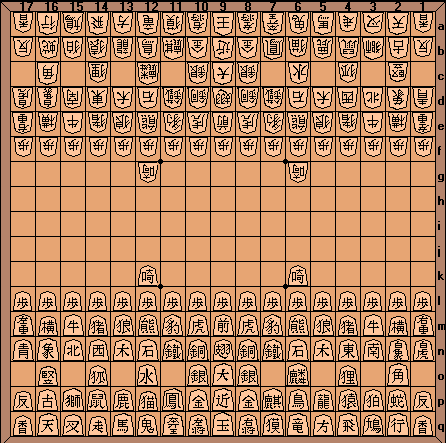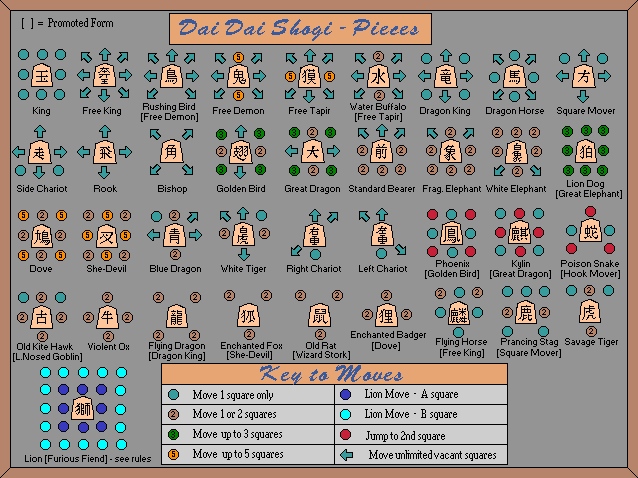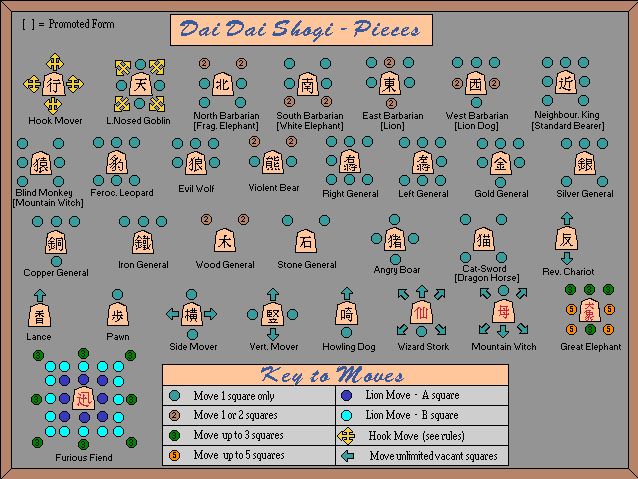Dai Dai Shogi (Large Large Shogi)
There were no reason to stop with Dai Shogi and its 15x15 board. As soon as the 15th century, three even larger variants are attested. They are Dai Dai Shogi (Large Large Shogi) over a 17x17 board, Maka Dai Dai (Ultra Large Large Shogi) over a 19x19 board and Tai Shogi (Grand Shogi) over a 25x25 board.
The complexity increasing is impressive. Dai Dai Shogi offers no less than 64 different types of piece, plus 4 more gotten after promotion, where Dai Shogi has only 36 types in total. Dai Dai Shogi has an asymmetrical starting set-up. The promotion by capture rules and the presence of the very powerful Hook Movers make Dai Dai Shogi a very different game from the smaller variants.
As with the other larger variants, there is no provision for returning captured pieces into play in Dai Dai Shogi.

SHORT DESCRIPTION:
Dai Dai Shogi is played on a board of 17 x 17 squares and each player has 96 pieces (including 17 pawns).
SPECIFIC RULES:
The Kylin, Phoenix and Poisonous Snake (and those pieces with Lion powers) have the power to jump over occupied squares.
In Dai Dai Shogi there are no restrictions on the capture of Lions (as there are in Chu Shogi). On promoting to Furious Fiend the Lion gains the power of the Lion Dog (ie: it can move up to 3 squares in any orthogonal or diagonal direction). The Furious Fiend can move as either a Lion or Lion Dog on any one turn (it can not combine the two powers in the same move).
The most powerful pieces in Dai Dai Shogi are the hook movers. The Hook Mover itself has a Double Rook move, being able to move any number of squares in any orthogonal direction, immediately followed by a further move at right angles to the first. The two legs of the Hook Mover move do not have to be of the same length, and it is not compulsory that it make the 2nd Rook move. To give some idea of the power of this move it is worth noting that the Hook Mover on an empty board would be able to reach any square in one turn! The Hook Mover is not a jumping piece, and must end its move on making a capture.
The Long-Nosed Goblin has hook moving powers in the diagonal directions (ie: it is effectively a Double Bishop), and in addition has the power to move one square orthogonally.
Promotion:
The promotion rules in Dai Dai Shogi (and its larger cousins) are very different from those in the smaller variants. In Dai Dai there are no Promotion Zones. A piece is promoted when it captures of an enemy piece. If a piece has a promoted rank and makes a capture, promotion is compulsory.
A piece that reaches the last rank of the board and does not have the power to retreat is left in play on the last rank until captured.
Unlike in Shogi, captured pieces in Dai Dai Shogi can not be 'dropped' back into play. A captured piece is removed from play and takes no further part in the game.



(From Steve Evans)
HISTORY:
Dai Dai Shogi was probably invented in the 15th century as it was included in Shogi rokushu no zushiki. However the oldest account that has survived until today of how the pieces moved was the 1694 publication of Nishzawa Teijin’s Sho Shogi Zushiki.





